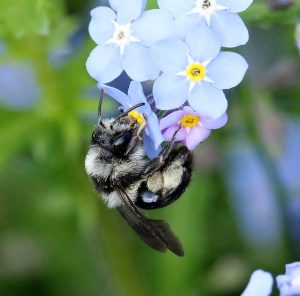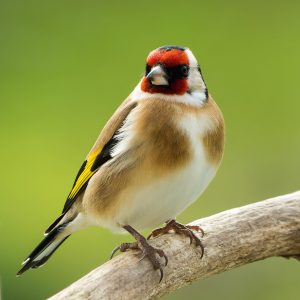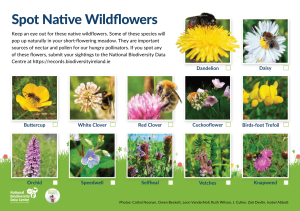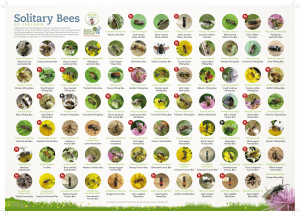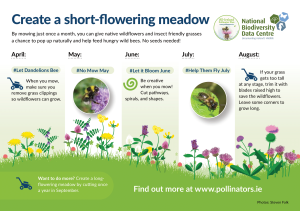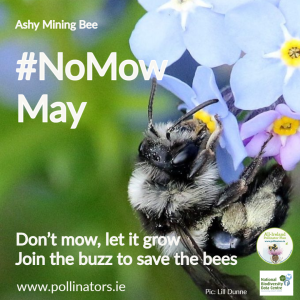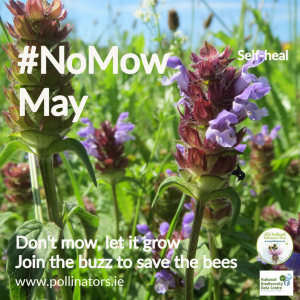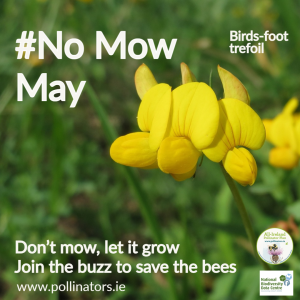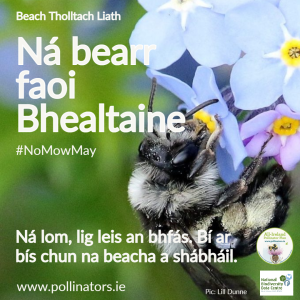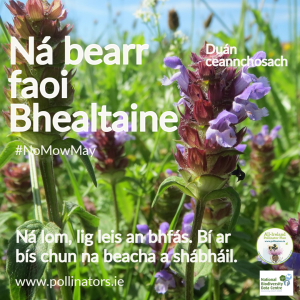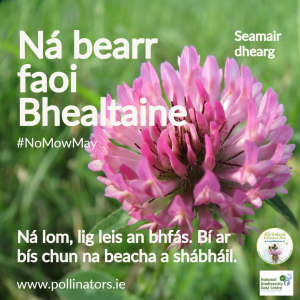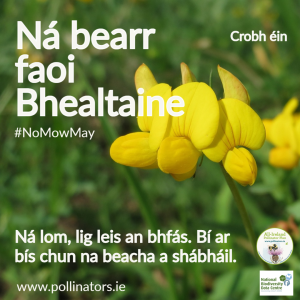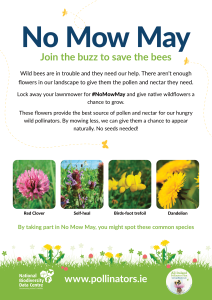No Mow May
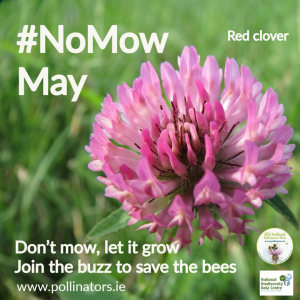 #NoMowMay is an annual campaign started by Plantlife in the UK, asking everyone to put away the lawnmower during the month of May to help our native wildlife.
#NoMowMay is an annual campaign started by Plantlife in the UK, asking everyone to put away the lawnmower during the month of May to help our native wildlife.
Native Irish wildflowers like Dandelions, Clover, and Birds-foot trefoil provide the best source of pollen and nectar for our hungry wild pollinators. By mowing less, we can give them a chance to appear naturally – no seeds needed!
But there’s no need to stop at May. Mowing less all summer is one of the best things you can do to help pollinators. So why not take part in Let it Bloom June and Help them Fly July?
Why should I take part?
On the island of Ireland, one third of our wild bees are threatened with extinction. This is mainly because of hunger – there isn’t enough food to support them in our landscape. If all of us chose to put our lawnmowers away for one month, we could start creating a network of places where pollinators can survive and thrive.
How can I join in?
Taking part in No Mow May couldn’t be easier – just lock away the lawnmower for the month of May and wait and see what grows. You might be surprised by what appears over a few short weeks. You might see plants like Dandelions, Red and White Clover, and Birds-foot trefoil, all of which are excellent sources of food for pollinating insects, as well as bees, butterflies, and birds, all attracted by the feast on your lawn!
From left to right: Grey Mining Bee (Lill Dunne), Goldfinch, Peacock Butterfly. Just some of the species you might see if you take part in No Mow May.
FAQs
Should Councils take part in No Mow May?
No Mow May is aimed at gardens and local communities, not councils. Councils can have a far bigger impact by developing a long-term strategy for creating a network of long and short-flowering meadows. Given the scale at which they manage areas of grass, they face unique challenges including managing large volumes of grass cuttings and balancing the needs of different land users.
I don’t have a lawn. How can I help?
If you don’t have a lawn, you can still help pollinators by planting a pollinator-friendly pot or window box with peat-free compost. Plants like Thyme, Chives, Oregano and Lavender are all excellent sources of pollen and nectar and can help feed the bees.
What flowers can I expect to see?
Take part in Now Mow May and see what appears – you might be surprised. Common wildflowers like Dandelions, Clovers and Self-heal will appear on many lawns if given the chance. If your lawn doesn’t have many wildflowers, it may be too fertile. By reducing mowing and removing the grass when you do mow, you gradually reduce the soil fertility and give wildflowers a chance to compete with the grass. Over time, lawns managed in this way become more and more flower rich.
How do I identify any bees or other pollinators that visit?
On the island of Ireland, most insect pollination is carried out by bees, followed by other insects like hoverflies and moths. You can find a full list of the 100+ wild bees we have in Ireland on these free posters.
You can learn more about pollinators including bees and hoverflies on our ‘Who are Our Pollinators?’ pages.
What can I do after May?
Mowing less from April until September is one of the best ways you can help pollinators. If you remove the grass clippings when you do mow, this slowly reduces the fertility of the soil, allowing native wildflowers to grow naturally.
There are a couple of pollinator-friendly mowing regimes you could adopt. Even managing a section or strip of your lawn in this way can make a difference, or a mixture of different regimes:
Short-flowering meadow: Take part in Let it Bloom June, and Help them Fly July. Cut once a month rather than every couple of weeks. Dandelions will flower in April, and Clovers in May and June. Other plants like Bird’s-foot-trefoil and Self-heal will naturally pop up later in the summer if given a chance. Find out more in our short-flowering meadow flyer:
Long-flowering meadow: In some areas, considering cutting just once a year in September after the seeds have dropped. You must remove the grass cut. This allows wildflowers to bloom throughout the summer such as Ox-eye daisy, Field scabious and Knapweed. It can take a couple of years for long-flowering meadows to fully establish, but after a few years of managing your meadow in this way you will be rewarded with a true, native, flower-rich meadow.
Leave some areas entirely undisturbed: Leaving some areas of undisturbed long grass provides safe nesting sites for insects over winter.
Should I plant wildflower seeds to speed things up?
Native meadows are disappearing across the island of Ireland. These important habitats are full of flowers that have evolved alongside our pollinators, offering the best source of pollen and nectar. No Mow May is a way of beginning to restore this habitat, creating small pockets of native meadows in our gardens and communities.
Mowing less allows local, native wildflowers to emerge naturally over time. Wildflower seed mixes and ‘seed ball’ type products usually result in colourful displays of non-native flowers. Sowing them in your lawn will not result in a native meadow.
I’ve only just heard about No Mow May – is it too late to start?
It’s never too late! Reducing mowing is one of the best ways to help pollinators at any time of year, regardless of when you start. Reducing mowing helps reduce the fertility of the soil over time, allowing local, native wildflowers to pop up naturally.
My partner/neighbours are wary – what should I do?
If you want to try No Mow May, but others aren’t so keen, try leaving a strip or patch of grass unmown and see what happens. Don’t be tempted to keep it to a dark or wet corner – flowers do need sun to grow!
I’m not getting flowers, just long grass
If your lawn is usually mown regularly and/or treated with herbicides, you won’t get wildflowers straight away. The soil needs time to recover, and this can take time. Keep going and you might be surprised at the variety of flowers that emerge, with more appearing year on year.
I’m worried I’ll have so much grass it’ll be difficult to cut it again.
It would be very unusual to get excessive amounts of grass after just four weeks, unless your lawn is exceptionally fertile. If you are worried – cut it when you feel you need to rather than leaving it for the entire month. Very fertile lawns may also see large plants like Docks appearing – if that’s the case you should manually remove those. That’ll only be necessary in initial years.
How much impact can one lawn have?
Every No Mow May area, no matter how small, can be a lifeline for your local pollinators. Bees don’t fly far from their nests to look for food (bumblebees tend to forage within 1km, and solitary bees only within a few hundred metres). If only a fraction of Ireland’s gardens took part in No Mow May, the collective impact would be huge.
Find out more about how you can help our pollinators
Creating a short-flowering meadow
Pollinator-friendly grass cutting
How-to guide: Creating and restoring meadows in local communities and gardens
Top Ten Actions for Pollinators
Join the buzz to save the bees
Find us on Twitter and Instagram and share your #NoMowMay lawn, or help spread the word with one of these free graphics.
Download the free No Mow May poster and inspire others to join the buzz to save the bees

